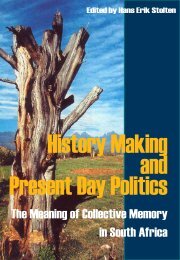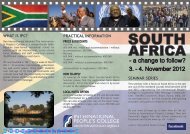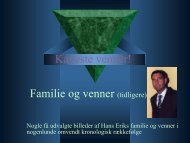At the end of the rainbow - Stolten's African Studies Resources
At the end of the rainbow - Stolten's African Studies Resources
At the end of the rainbow - Stolten's African Studies Resources
You also want an ePaper? Increase the reach of your titles
YUMPU automatically turns print PDFs into web optimized ePapers that Google loves.
16 The impact <strong>of</strong> <strong>the</strong> AIDS epidemic in South Africa<br />
By Hein Marais<br />
History has not been kind to South Africa. 30 After centuries <strong>of</strong> colonialism came one <strong>of</strong> <strong>the</strong><br />
most ferocious systems <strong>of</strong> institutionalized racism <strong>the</strong> world has known. For almost 50 years,<br />
apar<strong>the</strong>id wreaked havoc in <strong>the</strong> lives <strong>of</strong> black South <strong>African</strong>s while securing for whites<br />
possibly <strong>the</strong> highest standard <strong>of</strong> living in <strong>the</strong> developing world. By <strong>the</strong> early 1990s, after a<br />
long liberation struggle, <strong>the</strong> country was beginning to extricate itself from its ignominious<br />
past. The future seemed to be <strong>the</strong>re for <strong>the</strong> making—except that <strong>the</strong> country now found itself<br />
in <strong>the</strong> path <strong>of</strong> a swiftly-growing AIDS epidemic which, in a few years, would become <strong>the</strong><br />
worst such epidemic in <strong>the</strong> world.<br />
As South <strong>African</strong>s voted in <strong>the</strong>ir first democratic election in April 1994, few were thinking<br />
about AIDS, and even fewer had an inkling <strong>of</strong> what <strong>the</strong> epidemic held in store for <strong>the</strong>m and<br />
<strong>the</strong>ir country. A mere four years earlier, it had been estimated that less than 1% <strong>of</strong> adult South<br />
<strong>African</strong>s were infected with HIV, <strong>the</strong> virus that causes AIDS. An <strong>end</strong>uring sense <strong>of</strong><br />
exceptionalism encouraged <strong>the</strong> notion that South Africa, somehow, would evade <strong>the</strong> serious<br />
epidemics underway in o<strong>the</strong>r parts <strong>of</strong> East and Sou<strong>the</strong>rn Africa. The Communist Party leader<br />
Chris Hani was one <strong>of</strong> <strong>the</strong> rare public figures to have recognized <strong>the</strong> threat. In 1990, he had<br />
told conference-goers in Maputo that:<br />
Those <strong>of</strong> us in exile are especially in <strong>the</strong> unfortunate situation <strong>of</strong> being in <strong>the</strong> areas where <strong>the</strong><br />
incidence <strong>of</strong> this disease is high. We cannot afford to allow <strong>the</strong> AIDS epidemic to ruin <strong>the</strong><br />
realization <strong>of</strong> our dreams. Existing statistics indicate that we are still at <strong>the</strong> beginning <strong>of</strong> <strong>the</strong><br />
AIDS epidemic in our country. Unatt<strong>end</strong>ed, however, this will result in untold damage and<br />
suffering by <strong>the</strong> <strong>end</strong> <strong>of</strong> <strong>the</strong> century. 31<br />
HIV data highlight two prime features <strong>of</strong> South Africa’s epidemic: <strong>the</strong> astonishing speed with<br />
which it evolved (national adult HIV prevalence <strong>of</strong> less than 1% in 1990 rocketed to almost<br />
25% within 10 years), and its extraordinary intensity. When voters went to <strong>the</strong> polls for <strong>the</strong><br />
country’s second-ever democratic election in 1999, at least 3 million and possibly as many as<br />
4 million South <strong>African</strong>s were living with HIV, <strong>the</strong> virus that causes AIDS. 32 By 2006, that<br />
number had surpassed 5 million (ASSA, 2005). 33<br />
30 This article is based on Hein Marais’s book Buckling: The impact <strong>of</strong> AIDS in South Africa, published by <strong>the</strong><br />
Centre for <strong>the</strong> Study <strong>of</strong> AIDS at Pretoria University. An electronic version is available at<br />
http://www.sarpn.org.za/documents/d0001789/index.php<br />
31 Chris Hani, speaking at an AIDS conference in Maputo, Mozambique, 1990, cited in Marais H (2000). To <strong>the</strong><br />
edge: AIDS Review 2000. Pretoria, Centre for <strong>the</strong> Study <strong>of</strong> AIDS.<br />
32 The Actuarial Society <strong>of</strong> South Africa’s (ASSA) AIDS models are among <strong>the</strong> most sophisticated <strong>of</strong> <strong>the</strong>ir kind.<br />
The 1999 figure is derived from <strong>the</strong> ASSA 2002 model, which retrospectively estimated that 3.2 million South<br />
<strong>African</strong>s were living with HIV in that year. Using less nuanced assumptions and data, UNAIDS/WHO (2000)<br />
estimated <strong>the</strong>re were 4.2 million South <strong>African</strong>s with HIV at <strong>the</strong> <strong>end</strong> <strong>of</strong> 1999.<br />
33 ASSA (2005). ASSA 2003 AIDS and demographic model. Cape Town, ASSA. For a summary, see<br />
http://www.assa.org.za/scripts/file_build.asp?id=100000538&pageid=1000000022. The latest estimates <strong>of</strong> <strong>the</strong><br />
Actuarial Society <strong>of</strong> South Africa are that 5.2 million South <strong>African</strong>s were living with HIV in 2005, compared<br />
with <strong>the</strong> Joint United Nations Programme on AIDS (UNAIDS) estimate <strong>of</strong> 5.5 million.









